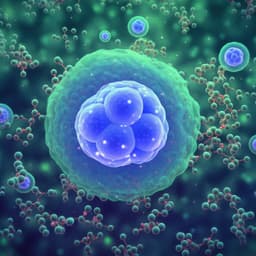
Medicine and Health
A selective frequency damping and Janus adhesive hydrogel as bioelectronic interfaces for clinical trials
J. Luo, Y. Jin, et al.
Discover the groundbreaking Janus adhesive hydrogel developed by researchers including Jiabei Luo, Yuefan Jin, and Linpeng Li, designed to enhance the accuracy of bioelectrical signal acquisition. This innovative hydrogel remarkably reduces breathing noise, achieving significant damping effects, and shows exceptional performance in clinical trials for diagnosing otitis media and sleep apnea.
~3 min • Beginner • English
Introduction
Bioelectrical signals are essential for clinical diagnostics and monitoring but are susceptible to motion artifacts, especially dynamic noise from respiration that persists even during rest, sleep, or anesthesia. Conventional signal processing approaches (e.g., bandpass filtering) can remove such noise but often at the cost of information loss and latency. Adhesive hydrogels used as bioelectronic interfaces improve skin compliance and reduce interfacial impedance, yet most exhibit isotropic adhesion, leading to residues that degrade device accuracy over repeated use. Prior damping hydrogels (e.g., phase-transition dampers) require external heating and are not optimized for clinical bioelectrical interfacing. The research question is whether a Janus adhesive hydrogel can be engineered to provide selective frequency damping in the respiratory band while simultaneously offering asymmetric adhesion to avoid residues and maintaining high-fidelity bioelectrical signal transmission suitable for clinical applications (e.g., ABR, PSG).
Literature Review
Signal processing methods, such as bandpass filtering, can suppress respiration-induced noise but may distort signals and introduce delays. Materials approaches have explored damping hydrogels (e.g., Park et al.’s phase-transition damper switching between rubbery/glassy states) and adhesive hydrogels leveraging mechanical interlocking, diffusion, and chemical bonding for improved electrode-tissue interfaces. Janus adhesive hydrogels, with asymmetric adhesion via spatial distribution of functional groups or nanoparticles, have been used to address adhesion-related issues and for wearable sensing and energy harvesting. However, existing Janus hydrogels do not simultaneously enable reliable bioelectrical transmission and selective removal of dynamic noise. Key challenges identified include: (1) balancing asymmetric adhesion with consistent bulk damping; (2) preventing signal distortion from asymmetric structures; and (3) reconciling weak bonds for selective energy dissipation with strong bonds for robust adhesion.
Methodology
Hydrogel design and fabrication: A Janus adhesive hydrogel (JAH) was engineered by combining natural sedimentation-assisted fabrication with gelation-limited sedimentation to form a gradient/asymmetric distribution of silver nanoparticles (Ag NPs). Composition (per Methods): 4 mL deionized water, 5 mL ethylene glycol (EG), 1.5 g acrylamide (AAm), 0.02 g tannic acid (catechol functionality), 1 g NaCl, 0.005 g MBA crosslinker, and 2 g Ag NPs. The mixture was stirred 20 min, degassed ultrasonically, initiated with 0.1 g APS in 1 mL water, poured into a 2 mm PTFE mold, and gelled at 45 °C for 20 min. Asymmetric Janus structure formation relied on: gravity-driven Ag NP sedimentation; Ag–radical coordination temporarily inhibiting sedimentation; and rapid radical depletion via Trommsdorff–Norrish effect enabling re-sedimentation, establishing a gradient of Ag NPs.
Adhesion and damping mechanisms: Adhesive side utilizes free catechol groups enabling Michael addition and hydrogen bonding at the skin interface, synergized with ionic coordination for robust adhesion; the Ag-rich opposite side suppresses effective adhesion, yielding asymmetry. Selective damping is achieved via energy dissipation through weak, reversible bonds that preferentially dissipate respiration-band dynamic noise (0.1–1 Hz); lower-frequency noise is too weak to break bonds (risking distortion), and higher-frequency noise exceeds dissipative capacity (rearrangement reduces loss modulus). No external heating is required.
Characterizations: Janus structure verified by SEM element mapping (Ag) for cross-sections and surfaces; optical imaging corroborated Ag gradients. Gelation time quantified by solid–liquid balance (SLB<0.5 indicates gelation) and dynamical instability profiling of top/middle/bottom regions to delineate five gelation stages. FTIR confirmed complete polymerization (loss of C=C at 1630 cm−1) and similar chemical structures on both faces.
Mechanical/damping: Dynamic mechanical analysis measured tan δ versus frequency for JAH, JAH without Ag, JAH aged 60 days, and commercial EEG gel. Energy absorption per volume was assessed in respiratory frequencies. Elasticity and loss factor differences between adhesive and non-adhesive layers were evaluated.
Adhesion tests: Asymmetric adhesion quantified by peel and shear tests on skin, PDMS, rubber, steel, and PTFE (n=4 per substrate), reporting ratios of adhesive vs non-adhesive faces.
Electrical performance: Electrochemical CV (cycling up to 1000 cycles) and EIS Bode plots characterized current density, reversibility, impedance (100–1000 Hz), and phase. Impedance was normalized to volume/contact/sheet parameters. Long-term stability tested by biphasic pulses (±0.1 V) for 10,000 cycles. AC signal transmission assessed with sinusoidal inputs (0.1–10 Hz, 0.1–1 V), waveform fidelity, and current magnitude versus a commercial EEG gel.
Biocompatibility and stability: Cell viability (L-929, 24 h), skin irritation/inflammation (mouse, 24 h), and long-term material stability (60 days at 25 °C, 60% RH) were evaluated.
Applications—ABR in rats: ABR recorded with RZ6 system using subdermal needle electrodes for reference/ground and JAH as non-invasive scalp interface; thresholds and SNR compared to invasive subdermal probes in healthy and otitis media models. Ethics approvals and protocols detailed.
Applications—Clinical PSG: PSG recorded with Philips Alice 6 system; EEG (F4, C4, O2), EOG (LEO, REOG), ECG via JAH; commercial gel used at symmetric EEG locations for comparison. Bandpass filters followed AASM guidelines. Analysis included Fourier transforms to assess damping (0.1–1 Hz), RMS noise, signal amplitudes, sleep staging, and AHI computation for OSA diagnosis. Asymmetric adhesion strategy connected non-adhesive face to electrodes and adhesive face to skin to avoid residues.
Key Findings
- Selective frequency damping: JAH exhibits a damping effect in the respiration frequency range (0.1–1 Hz) approximately 60× greater than in non-respiratory ranges; tan δ remains high and stable, including after 60 days of storage.
- Asymmetric adhesion: Shear adhesion ratios (adhesive/non-adhesive faces) reached 537× (skin), 41× (PDMS), 342× (rubber), 205× (steel), 270× (PTFE); peel adhesion ratios were 28× (skin), 28× (PDMS), 29× (rubber), 27× (steel), 20× (PTFE).
- Electrical performance: Impedance <50 Ω at 100–1000 Hz; phase behavior consistent with resistive conduction; CV showed higher current density and near-ideal reversibility vs commercial EEG gel; non-adhesive (Ag-rich) face had lower impedance. Under sinusoidal input (1 Hz, 0.1 V), JAH showed no waveform distortion, unlike commercial gel. Current amplitude advantage vs commercial gel increased from 18.9× to 53.1× after 1000 cycles. Waveform fidelity maintained from 0.1–10 Hz, whereas commercial gel degraded significantly at low frequencies.
- Endurance: Stable charge injection/ejection under biphasic ±0.1 V pulses for 10,000 cycles without performance degradation.
- Mechanistic enhancements: Ag NPs improved dielectric constant, homogenized ion distribution, extended Debye length, and intensified local electric fields via nanoparticle polarization, collectively enhancing charge transfer and signal integrity.
- Biocompatibility and stability: 24 h cell survival rate 94.27%; no skin inflammatory response; material properties (including damping) stable over 60 days.
- ABR (healthy rats): Across decibel levels, JAH produced larger ABR amplitudes than invasive probes; detection threshold 25 dB (JAH) vs 35 dB (invasive); improved SNR.
- ABR (otitis media rats): Invasive probe detected responses only ≥45 dB, whereas JAH detected down to 35 dB; invasive recordings showed reduced amplitudes and loss of characteristic peaks, while JAH preserved features due to respiration-noise damping.
- Clinical PSG: JAH reduced dynamic noise (0.1–1 Hz) in ECG/EEG/EOG, improved RMS noise and amplitudes vs commercial gel, captured canonical sleep-stage features (alpha, sawtooth, slow eye movements, spindles/K-complexes, delta waves), enabled accurate staging and AHI-based OSA diagnosis. Asymmetric adhesion prevented electrode residue and maintained interface quality over time.
Discussion
The study addresses the challenge of respiration-induced dynamic noise and residue-prone isotropic adhesives in clinical bioelectronic interfaces. By engineering a Janus hydrogel that separates weak, reversible damping bonds from strong interfacial adhesion bonds and introducing Ag nanoparticles to tailor dielectric and conductive properties, the device selectively dissipates respiration-band noise without signal distortion or added thermal components. The asymmetric Ag gradient provides strong adhesion to tissue while minimizing adhesion to devices, preventing residue and preserving electrode integrity. Electrical analyses (low impedance, near-ideal CV, stable phase) and endurance tests (10,000 cycles) confirm robust, long-term interfacing. In vivo rat ABR experiments demonstrate higher sensitivity and lower thresholds than invasive electrodes, particularly under otitis media conditions where characteristic peaks are preserved. Clinical PSG validates improved noise suppression, signal fidelity, and practical advantages (no residue), enabling effective sleep staging and OSA diagnosis. These results suggest that materials-level selective damping can outperform post hoc filtering by avoiding information loss and latency, and that Janus architectures can reconcile the tension between damping and adhesion for high-fidelity clinical bioelectronics.
Conclusion
A Janus adhesive hydrogel (JAH) was developed that combines selective frequency damping in the respiration band with asymmetric adhesion and enhanced electrical properties. The material achieves up to 537× adhesion asymmetry, ~60× selective damping in the respiratory range, low impedance at physiologically relevant frequencies, and durable performance over 10,000 cycles. It enables non-invasive ABR detection with lower thresholds and higher sensitivity than invasive probes and delivers superior clinical PSG performance, supporting accurate sleep staging and OSA diagnosis while eliminating adhesive residues. Future work should focus on advancing damping hydrogel chemistries for broader frequency selectivity, integrating hydrogels with electronics for fully conformal, stable interfaces, and refining scalable fabrication to standardize Janus gradients and device form factors for diverse clinical applications.
Limitations
Related Publications
Explore these studies to deepen your understanding of the subject.







